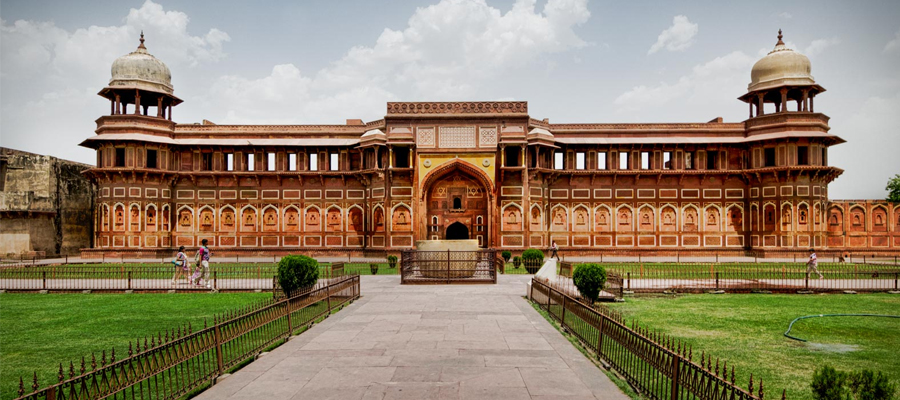
Overview
The proud seat of the alluring Taj Mahal and a treasure trove of testimonies to the opulent Mughal era – that’s Agra for you! The cityscape is literally sprinkled with exquisite historical edifices, each buzzing with tourist activities day in and day out. Among 15 Ultimate Places to Visit in Agra are Fatehpur Sikri, Agra Fort and Taj Mahal are UNESCO world heritage sites.
Introducing Agra
Heritage Places / Sightseeing in Agra
- Taj Mahal
The spectacular white marble mausoleum often overshadows the rest of the Agra Tourist Attraction Places for tourists on a whistle-stop tour. Often praised with metaphors, like "a teardrop on the cheek of eternity" by the great poet Rabindra Nath Tagore and "an embodiment of all things pure" by Rudyard Kipling, – the beauty of the Taj Mahal has always been described as sublime and out of this world.
Globally admired for its superlative symmetry, the Taj Mahal in Agra is also observed as a symbol of undying love that a man had for a woman. As legend has it, the Mughal Emperor Shah Jahan commissioned this utmost exquisite hand-made mausoleum in 1632 to commemorate his much-adored chief consort Mumtaz Mahal, upon most unfortunately losing her to complications during the birth of their 14th child a year earlier.
It took the non-stop labour of 20,000 workers for 22 years to build this masterpiece of symmetry combining elements of Persian, Indian and Islamic architectural styles in perfect harmony. Interestingly, the task force also comprised of 1000 elephants, which were used to transport a large number of precious stones (like crystal, sapphire, jade, turquoise, lapis, lazuli, diamonds etc.) and corals from Afghanistan, China, Persia, Sri Lanka and Tibet. The construction of the Taj finally came to a close in 1653.
There is a small museum on the western side of Taj Mahal's compound showcasing a wholesome collection of Mughal portraits, painting, coins and porcelain, including detailed drawings of the making of the Taj.
The main structure is flanked by two identical red sandstone mosques. While the mosque on the left is fully functional and used for offering Friday prayers, the one on the right known as Jawab had been constructed only for the sake of symmetry. Jawab is considered inappropriate for holding prayers having its face away from the Mecca.
- The Agra Fort
Red Fort in Agra is another UNESCO world heritage site, only second to the Taj Mahal. The fort is one of the finest and most massive red sandstone forts in India. It has several beautiful architectural features inside including the Moti Masjid (Pearl Mosque), Diwan-I-Am (hall designated to hold audience with public), Diwan-I-Khas (hall for audience with visiting dignitaries), Shish Mahal (Mirror Palace), Nagina Masjid (Gem Mosque), the Khas Mahal, Anguri Bagh, Jahangir's Palace, Hauz-i-Jahangir, Takhti-i-Jahangir, and of course, the white-marble octagonal tower called Musamman Burj, where deposed Emperor Shah Jahan breathed his last while gazing out at the Taj Mahal from one of its marble balconies.
The fort was originally commissioned in 1565 by Emperor Akbar for military use. Later on, Akbar's grandson Shah Jahan extensively renovated the fort to transform it into a palace and brought it to its present form. The fort is modeled like a human ear with towering twin walls at its boundaries and dogleg shaped entrance built to confuse an invader. The fort also has a two-storied maze of underground rooms running in several hundred in number.
- Itmad-Ud-daulah or Baby Taj
Itmad-Ud-daulah's tomb in Agra is a significant monument, often referred to as "Baby Taj". It is widely perceived as the precedent to the architectural plan of the Taj Mahal. The tomb signifies turn of a new leaf in Mughal architecture with a significant shift from red sandstone buildings to pure white marble structures inlaid with detailed pietra dura work. The tomb was commissioned by Noor Jahan (the chief consort of Mughal Emperor Jahangir) for her father.
- Chini Ka Rauza
Only 1 km north of the Itmad-Ud-daulah lays Chini ka Rauza, which is an unusual funerary monument from 1635, featuring one of the finest instances of glazed tile façade (now faded and damaged). The rectangular representative of Indo-Persian architecture houses the tomb of Allama Afzal Khan Mullah, who was the Prime Minister of the Mughal Emperor Shah Jahan.
- Jama Masjid and Kinari Bazaar
Built by Shah Jahan for his favorite daughter Jahanara Begum in 1648, the Jama Masjid in Agra stands right across the Agra Fort and overlooks the Agra Fort Railway Station. The mosque was once connected to the fort with a spacious octagonal tripolia chowk (courtyard) that was later demolished to make way for the railway station.
The mosque is mostly made up of red sandstone featuring interesting marble pattern on its domes. Still in use, the mosque also serves as an important landmark in the city, especially for checking out the bustling Kinari Bazaar (market) that flourishes right behind it.
A labyrinthine network of narrow overcrowded streets houses markets of just about everything one can imagine – from garments, stonework, snacks, spices, shoes to precious jewellery – collectively called as the Kinari Bazaar. Not to mention, the narrow lanes, otherwise exceedingly full of people, curiously manage to squeeze through buffaloes and sometimes fully grown elephants and carry on with their usual business. Having a walk through the bazaar in itself is a unique experience, even if it is undertaken without any intention to shop at all.
- Mehtab Bagh
One cannot possibly claim to have exhausted all tourism prospects in Agra without looking at the Southern view of the majestic Taj Mahal from this riverfront garden. Situated on the North of the Taj Mahal across the Yamuna River, the Mehtab Bagh (or a moon lit pleasure garden) is immaculately aligned to the Taj on the opposite side of the river bank. Visiting here on a Friday gives you the golden opportunity to see the Taj minus the crowds of tourists stomping about.
- Ram Bagh
The oldest surviving riverfront Mughal garden originally laid out by Babur in 1528, Ram Bagh is the place where Babur was buried temporarily before being interred in Kabul. Located barely 5 km towards NorthEast of the Taj Mahal, the Persian garden has a network of canals and pathways dividing the garden to signify the Islamic ideal of paradise where rivers flow through an abundant garden.
- Sikandra Mausoleum
Sikandra Mausoleum or Akbar's Tomb is just 10 km drive away from Agra. The construction of the mausoleum was started by Akbar himself but accomplished only in 1613 by his successor son Jahangir. This explains why the tomb witnesses amalgamation of architectural elements used during Akbar's reign, as well as, those found favor during the rule of Jahangir; blending domineering use of bold red sandstone across the structure, however, extensively adorned with adroitly crafted white marble including inlaid panel in geometric, floral and calligraphic designs.
- Fatehpur Sikri City
About 39 km from Agra sits Fatehpur Sikri city in red sandstone that sprawls 3 km in length, 1 km in width and surrounded by a 6 km long wall on three sides. The magnificent palace-city was founded by Emperor Akbar in 1569 so as to shift his capital in Agra around the camp of Sufi Saint Shaikh Salim Chishti.
The construction of the city was planned along the Persian principles, however assimilating some regional architectural influences. It was accomplished after 15 years of non-stop labour, however, only to be vacated forever in 1585 due to the paucity of water as well as proximity to Rajputana territories.
The popular architectural features of the palace-city complex include the Buland Darwaza, Jama Masjid, Tomb of Salim Chisti, Diwan-i-Aam, Diwan-i-Khaas, Naubat Khana, Ibadat Khana, Panch Mahal and Birbal's house.
- Soor Sarovar Bird Sanctuary which is just 20 km and a home to Sloth Bear/ Elephant rescue facility.
- Firozabad just 44 Km which is referred as a bangle city of India.
- Bharatpur Bird Sanctuary
- Chambal Sanctuary
- Bateshwar
How to reach Agra
By AirNearest airport to Agra is Kheria, barely 13 km drive from Agra city. The airport serves as a military base and operates as a commercial airport on a seasonal basis. Only Air India flights connect Delhi to Agra and take less than 60 minutes to transport tourists to the Kheria airport.
By RailBeing located on the Delhi-Mumbai & Delhi-Chennai track, Agra is well-connected to almost all the cities of India by rail. Trains leave regularly for Chennai, Mumbai and Kolkata from 05 railway stations in its territory - including Agra Cantt Railway Station, Raja Ki Mandi, Agra Fort Railway Station, Agra City and Idgah Railway Station. Agra Cantt Railway Station is the main railway station from where trains from Agra to Jaipur operate frequently, making life easier for tourists on the golden triangle tour.
By RoadBuses by UP State Road Transport Corporation as well as several private players play regularly at the two interstate bus terminals in Agra to ferry tourists to a host of nearby cities – including Delhi, Lucknow, Jaipur, Kanpur and Gwalior. Idgah Bus Stand is just 8 km away from Taj Mahal whereas, ISBT at 12 km in distance.
What is the best time to visit Agra?
The weather in Agra is typically hot during the summer season from April to July. However, this is also the season when the crowd is the thinnest and attractive off-season deals are on offer.
From August till October, monsoon season envelops Agra and leaves it even more enchanting with rain-washed monuments looking brighter and more attractive.
The best time to visit Agra, however, remains between October and March (both months inclusive) when autumn followed by winter grace the city. The climate is ideal for sightseeing, shopping and of course sipping coffee at a rooftop restaurant with a mesmerizing view of the majestic Taj Mahal in the horizon.

